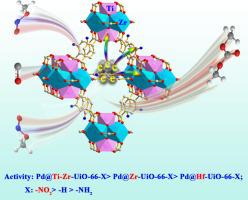当前位置:
X-MOL 学术
›
Chem. Eng. J.
›
论文详情
Our official English website, www.x-mol.net, welcomes your feedback! (Note: you will need to create a separate account there.)
Electronic structure and microenvironment modulation of Pd@UiO-66 enhances direct CO esterification to dimethyl carbonate
Chemical Engineering Journal ( IF 15.1 ) Pub Date : 2024-05-01 , DOI: 10.1016/j.cej.2024.151736 Yu-Ping Xu , Wen-Fa Chen , Ming-Sheng Wang , Bin-Wen Liu , Shuai-Shuai Hu , Zhong-Ning Xu , Guo-Cong Guo
Chemical Engineering Journal ( IF 15.1 ) Pub Date : 2024-05-01 , DOI: 10.1016/j.cej.2024.151736 Yu-Ping Xu , Wen-Fa Chen , Ming-Sheng Wang , Bin-Wen Liu , Shuai-Shuai Hu , Zhong-Ning Xu , Guo-Cong Guo

|
While the microenvironment around metal catalytic sites is recognized to be crucial in heterogeneous catalysis, its roles in CO esterification to dimethyl carbonate remain subtle. Herein, Pd nanoparticles are confined into the metal–organic frameworks with Ti metal substitutions and functional linker groups, namely Pd@Ti-Zr-UiO-66-X (X = H, NH, NO). The partial substitution of metal nodes by Ti species can dramatically enhance the activity of CO, and synergistically improves catalytic performance with electron-withdrawing functionalized nitroxide linkers. As a result, Pd@Ti-Zr-UiO-66-NO exhibits superior conversion of CO (67.5%), selectivity for DMC (83.5%, based on all products) and WTY for DMC (1725 g·kg·h) much higher than those of Pd@Zr-UiO-66-H with conversion of CO (46.4%), selectivity for DMC (87%) and WTY for DMC (1175 g·kg·h). Based on results of experimental and DFT calculation, the synergistic effect of highly electronegative Ti species and nitro-functional linker groups with electron-withdrawing ability realizes the precise control of the electronic structure and microenvironment of Pd NPs. The number of charges transferred from Pd NPs to Zr-UiO-66 and Ti-Zr-UiO-66-NO increased from 1.83 to 2.69 e, respectively. The microenvironment of electron-deficient palladium species and Ti-Zr-UiO-66-NO promotes the activation of MN and CO, which exhibits a superior performance in direct CO esterification to dimethyl carbonate. This study not only provides a new approach for rational modulation of the chemical microenvironment of metal centers and optimization of catalytic performance but also offers important insights for the design of heterogeneous catalysts.
中文翻译:

Pd@UiO-66的电子结构和微环境调节增强了CO直接酯化生成碳酸二甲酯
虽然金属催化位点周围的微环境被认为在多相催化中至关重要,但它在 CO 酯化为碳酸二甲酯中的作用仍然很微妙。在此,Pd纳米颗粒被限制在具有Ti金属取代和功能连接基团的金属有机框架中,即Pd@Ti-Zr-UiO-66-X(X=H、NH、NO)。 Ti物种部分取代金属节点可以显着增强CO的活性,并与吸电子功能化硝基氧连接体协同提高催化性能。因此,Pd@Ti-Zr-UiO-66-NO 表现出优异的 CO 转化率(67.5%)、DMC 选择性(83.5%,基于所有产品)和 DMC WTY(1725 g·kg·h) CO 转化率 (46.4%)、DMC 选择性 (87%) 和 DMC WTY (1175 g·kg·h) 均高于 Pd@Zr-UiO-66-H。基于实验和DFT计算的结果,高负电性Ti物种和具有吸电子能力的硝基功能连接基团的协同作用实现了Pd NPs电子结构和微环境的精确控制。从 Pd NP 转移到 Zr-UiO-66 和 Ti-Zr-UiO-66-NO 的电荷数分别从 1.83 e 增加到 2.69 e。缺电子钯物种和Ti-Zr-UiO-66-NO的微环境促进了MN和CO的活化,在CO直接酯化生成碳酸二甲酯中表现出优异的性能。该研究不仅为金属中心化学微环境的合理调控和催化性能的优化提供了新的方法,而且为多相催化剂的设计提供了重要的见解。
更新日期:2024-05-01
中文翻译:

Pd@UiO-66的电子结构和微环境调节增强了CO直接酯化生成碳酸二甲酯
虽然金属催化位点周围的微环境被认为在多相催化中至关重要,但它在 CO 酯化为碳酸二甲酯中的作用仍然很微妙。在此,Pd纳米颗粒被限制在具有Ti金属取代和功能连接基团的金属有机框架中,即Pd@Ti-Zr-UiO-66-X(X=H、NH、NO)。 Ti物种部分取代金属节点可以显着增强CO的活性,并与吸电子功能化硝基氧连接体协同提高催化性能。因此,Pd@Ti-Zr-UiO-66-NO 表现出优异的 CO 转化率(67.5%)、DMC 选择性(83.5%,基于所有产品)和 DMC WTY(1725 g·kg·h) CO 转化率 (46.4%)、DMC 选择性 (87%) 和 DMC WTY (1175 g·kg·h) 均高于 Pd@Zr-UiO-66-H。基于实验和DFT计算的结果,高负电性Ti物种和具有吸电子能力的硝基功能连接基团的协同作用实现了Pd NPs电子结构和微环境的精确控制。从 Pd NP 转移到 Zr-UiO-66 和 Ti-Zr-UiO-66-NO 的电荷数分别从 1.83 e 增加到 2.69 e。缺电子钯物种和Ti-Zr-UiO-66-NO的微环境促进了MN和CO的活化,在CO直接酯化生成碳酸二甲酯中表现出优异的性能。该研究不仅为金属中心化学微环境的合理调控和催化性能的优化提供了新的方法,而且为多相催化剂的设计提供了重要的见解。






























 京公网安备 11010802027423号
京公网安备 11010802027423号